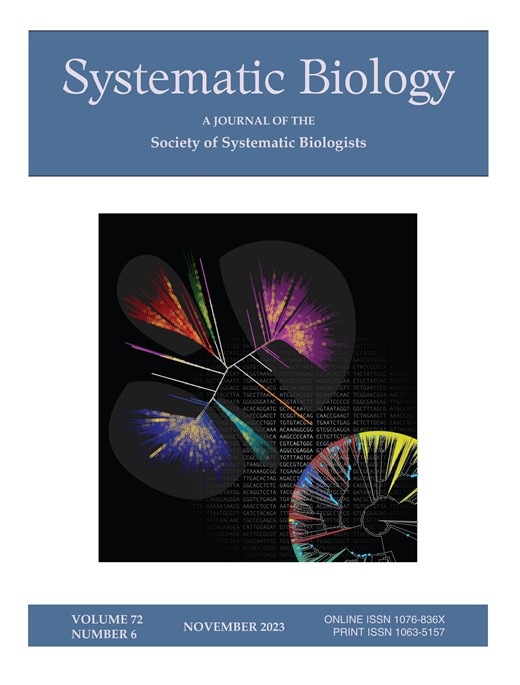Hybridization and Polyploidy shaped the Evolutionary History of a Complex of Cryptic Species in European Woodrushes (Luzula sect. Luzula).
IF 5.7
1区 生物学
Q1 EVOLUTIONARY BIOLOGY
引用次数: 0
Abstract
Polyploidization has played a central role in the evolutionary history of most plant lineages, yet it poses significant challenges for phylogenetic inference, particularly in allopolyploid complexes with reticulate species relationships. Luzula sect. Luzula (Juncaceae) is a taxonomically intricate group characterized by widespread polyploidy, agmatoploidy, and high morphological uniformity. Focusing on the Eastern Alps, a key center of its diversity, we collected 1,002 samples of nine species and applied an integrative framework combining ddRADseq, plastid sequencing, relative genome size estimation, and chromosome counting to disentangle its evolutionary history. We extended previously inferred phylogenetic relationships and assessed gene flow among diploids, establishing a baseline for investigating the origin of polyploids. By analyzing patterns of genotype frequencies and genetic affinities to diploids, we inferred the most likely parental species of polyploids and identified key hybridization events shaping the current taxonomic and karyotypic diversity within this group. Our results reveal weak genetic differentiation among some diploid lineages, likely reflecting gene flow and incomplete lineage sorting. We propose a common allopolyploid origin of two tetraploids, which subsequently gave rise to a third tetraploid and a hexaploid species through interploidy hybridization. Although the parental species of some polyploids remain obscure, our genomic data highlight polyploidy and hybridization as major drivers of speciation in this poorly understood lineage. This study underscores the value of integrative approaches in resolving reticulate plant phylogenies and advances our understanding of polyploid speciation.杂交和多倍体形成了欧洲木桐属(Luzula sect. Luzula)隐种复合体的进化史。
多倍体在大多数植物谱系的进化史中发挥着核心作用,但它对系统发育推理提出了重大挑战,特别是在具有网状物种关系的异源多倍体复合体中。灯花属(灯花科)是一个分类复杂的类群,其特征是广泛的多倍体、双倍体和高度的形态均匀性。本研究以青藏高原东部阿尔卑斯地区为研究对象,采集了9个物种的1002份样本,采用ddRADseq、质体测序、相对基因组大小估算和染色体计数等综合分析框架,对其进化历史进行了梳理。我们扩展了先前推断的系统发育关系,并评估了二倍体之间的基因流动,为研究多倍体的起源建立了基线。通过分析基因型频率和与二倍体的遗传亲和性模式,我们推断出多倍体最可能的亲本物种,并确定了形成该群体当前分类和核型多样性的关键杂交事件。我们的研究结果显示,一些二倍体谱系之间的遗传分化较弱,可能反映了基因流动和不完整的谱系分类。我们提出了两个四倍体的共同异源多倍体起源,随后通过倍间杂交产生第三个四倍体和一个六倍体物种。虽然一些多倍体的亲本物种仍然不清楚,但我们的基因组数据强调多倍体和杂交是这个知之甚少的谱系中物种形成的主要驱动因素。这项研究强调了综合方法在解决网状植物系统发育中的价值,并促进了我们对多倍体物种形成的理解。
本文章由计算机程序翻译,如有差异,请以英文原文为准。
求助全文
约1分钟内获得全文
求助全文
来源期刊

Systematic Biology
生物-进化生物学
CiteScore
13.00
自引率
7.70%
发文量
70
审稿时长
6-12 weeks
期刊介绍:
Systematic Biology is the bimonthly journal of the Society of Systematic Biologists. Papers for the journal are original contributions to the theory, principles, and methods of systematics as well as phylogeny, evolution, morphology, biogeography, paleontology, genetics, and the classification of all living things. A Points of View section offers a forum for discussion, while book reviews and announcements of general interest are also featured.
 求助内容:
求助内容: 应助结果提醒方式:
应助结果提醒方式:


